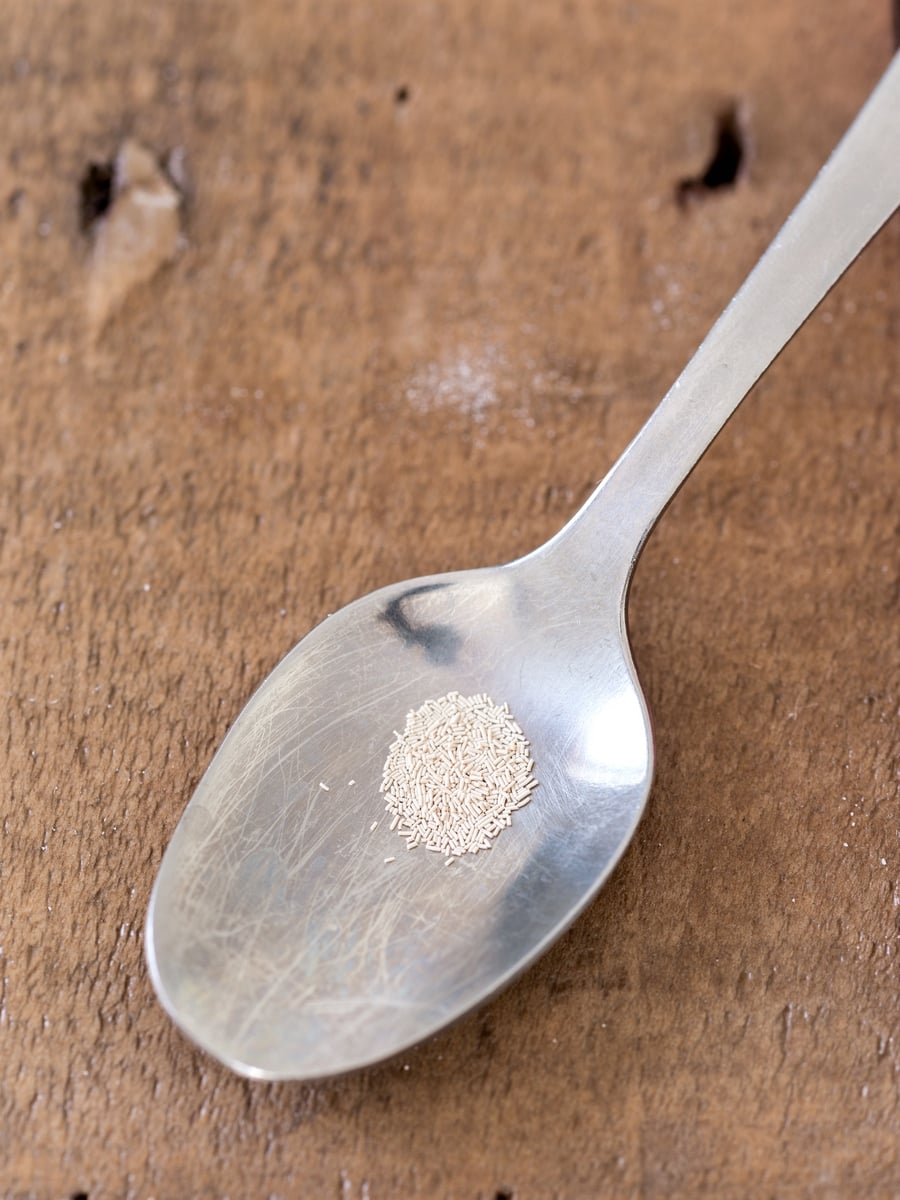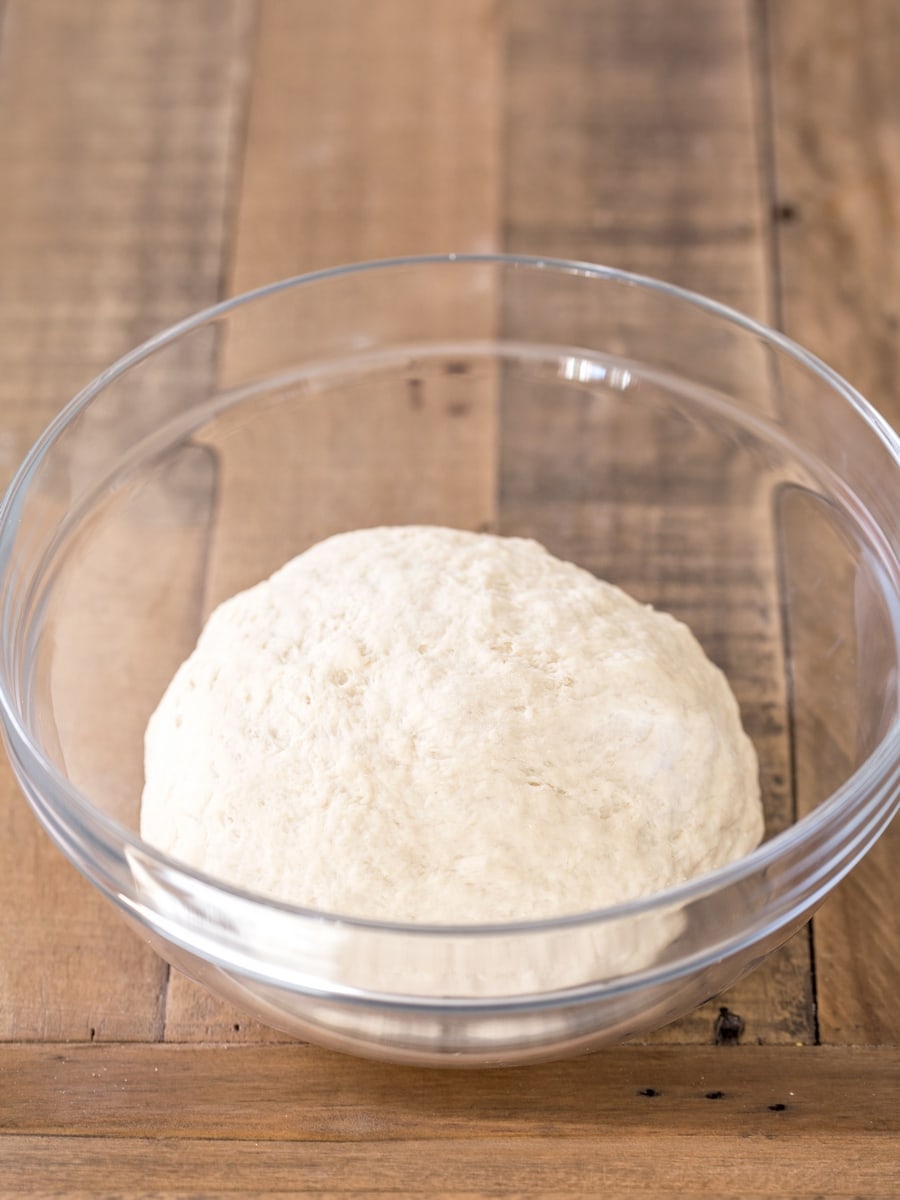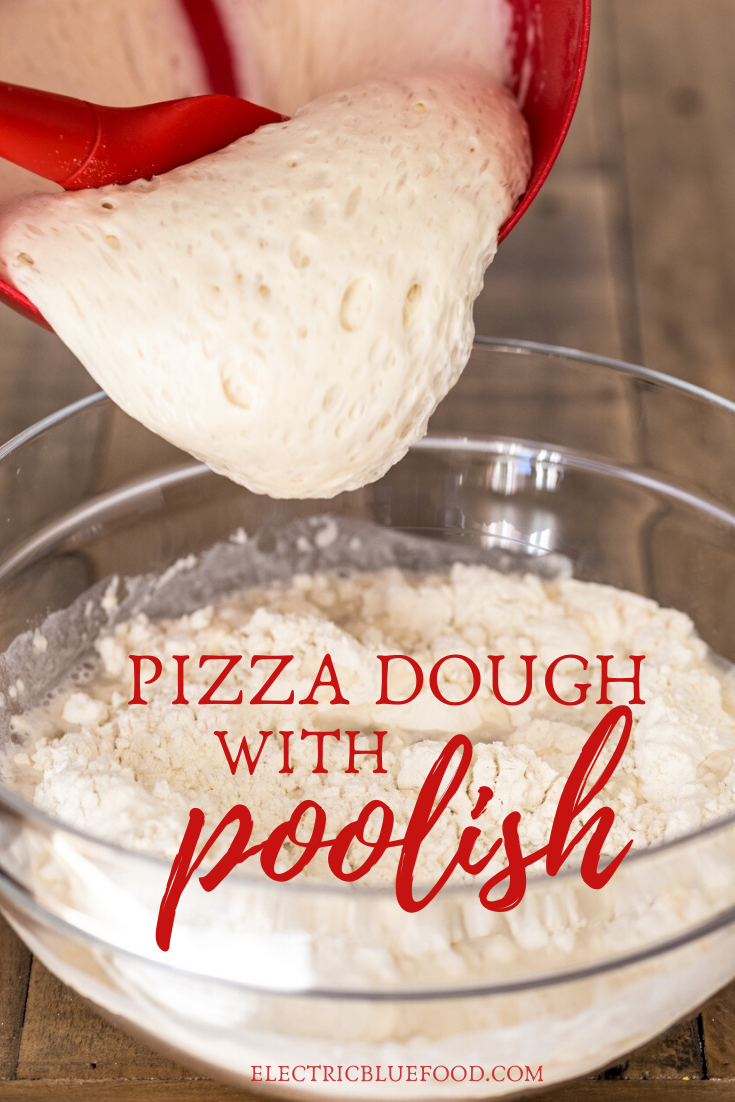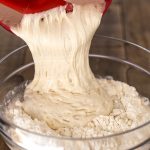Making pizza dough with a poolish means adding a pre-ferment to your pizza dough, rather than adding yeast. Yeast is used in minimal quantities to kickstart fermentation. Pizza made with poolish achieves a lovely texture and bite, while also being easier to digest. If you’re looking for an alternative pizza base recipe, you should definitely give poolish pizza dough a try. It might become your favourite pizza crust recipe.

My favourite pizza dough recipe
Seriously. This is my favourite pizza dough recipe. Credits go to my ex co-worker Michele, a fellow foodie and Italian expat in Krakow. He is the one who first introduced me to poolish pizza dough and kindly shared his recipe with me. The funny thing is that we did not call the pre-ferment a poolish. I copied his recipe in Italian and the pre-ferment was always referred to as lievitino.
It was only when I got into sourdough bread-making that I learned that a pre-ferment can have various names, and the lievitino technique that Michele had taught me was actually a poolish. What’s even more funny is that the term “poolish” is derived from the word “Polish” as it was Polish bakers that spread this pre-fermentation technique throughout Europe. And I happened to learn this pizza dough recipe with poolish from an Italian in Poland. This was one of those “nothing in life happens by chance” moments.

What is a poolish?
A poolish is a pre-ferment that gets added to the dough in bread and pizza making. A poolish is made of flour, water and a very tiny amount of commercial yeast. It is then left to ferment for about 8-12 hours. This is also known as “sponge” due to the very airy and spongy texture it develops during its fermentation (see pictures below). There are actually two types of sponge used in bread baking: poolish and biga. While biga is drier, poolish has 100% hydration, which means that you are adding 100% of the weight of flour in water.
This process may resonate with that of making a sourdough starter. In fact, we are somewhat applying the same concept with a poolish. Making a poolish is like making a levain: you are creating a pre-fermentation that will then be added to your final dough. What distinguishes a poolish from a proper sourdough starter is time. A poolish only requires 8-12 hours to make, while a sourdough starter can require something between 5 and 8 days. But if you have an active sourdough starter at hand you can also make a pre-fermented pizza dough using that! Read on to see my pre-fermentation recipe two ways.
If this all sounds a bit obscure to you, I invite you to hop over to my sourdough starter for beginners post where I have explained the very basics of a sourdough starter and the wonders you can make with it. Don’t worry, making pizza with poolish is much more simple than it may seem!

How to make a poolish
To make a poolish you have to mix together the same weight in water and flour, and add a minimal amount of yeast. Michele’s recipe called for 5 g of fresh yeast, the one that comes in cubes. 5 g is generally the minimum weight a home kitchen scale will show, making it easy to measure. While I often use fresh yeast, when that is not available I turn to my instant yeast packets I keep as backup in my pantry.
One packet of dry yeast (14 g) subs a whole 50 g cube of fresh yeast. So if we need the equivalent of 5 g of fresh yeast we will need to use about 1 g of instant yeast. And that is not something you can measure with a regular kitchen scale. What I did the first time was to halve the content of my dry yeast packet until I got to 1/10 which is what I needed in this recipe and it became a very tiny amount, something that is even less than 1/8 tsp. A sprinkle, really.

In fact, the longer the resting time, the smaller the amount of yeast you need. The opposite is also true: the shorter the time, the more yeast you will need. Since we’re making our pre-ferment the night before, our poolish will have enough time to ferment even if we put too little yeast in it.
Just like when making regular pizza dough you would add a little sugar to activate your yeast, Michele’s recipe calls for the same procedure even in the poolish phase. If using fresh yeast, add it to 300 ml of lukewarm water together with a teaspoon of honey, dissolve, and pour this mixture into a bowl with 300 g of flour. If using instant yeast like I am in this post, there is no need to dissolve the yeast in water. Stir a teaspoon of honey into lukewarm water, and in the other bowl you mix the yeast directly into the flour.
Give the mixture a stir until it gets homogeneous, cover with cling film and leave at room temperature overnight. As you can see making a poolish is very easy, just like stirring water and flour. The yeast will do its thing while you sleep and the following morning you will have your sponge ready to use. You know everything has gone well if it has doubled in size and it shows a very bubbly top.

How to make poolish pizza dough
Making pizza dough with a poolish is not more difficult than making regular pizza. All you have to do is combine flour and more water and add the pre-ferment. When pouring the poolish out of its bowl you will fully see why this is called a sponge:
At this point the dough will be quite sticky so I recommed to work it with a wooden spoon or a spatula in a large bowl. Only when it starts coming together you can proceed and mix in the salt. The quantities we are using in this recipe are:
- all of your mature poolish
- 800 g flour (preferably manitoba)
- 300 ml water
- 20 g table salt*
*Update: If you are using sea salt it will likely be quite strong in flavour, so 20 g will be more than enough. In Poland where I learned to make this dough I was using rock salt which has a milder flavour, and the salt I have here in Sweden where I am located now is as mild as the one I was using in Poland. I usually put 30 g of salt, aware that this is a rather mild salt. Start with 20 and if you notice that it’s not enough, it might be that you are also using a mild salt and could do a little bit more.
When most of the flour has been incorporated, pour the mixture onto a working surface and knead it until you get a proper dough. You can easily knead it by hand, as it shouldn’t take more than a couple of minutes at this point. You can go ahead and add a couple of tablespoons of olive oil if you wish so. You know your dough has the right consistency when it feels elastic but not sticky. According to the flour you’re using you may need to add a sprinkle of flour to achieve the right consistency, if you feel like it’s too sticky.
When the dough is ready, put it back into the bowl, cover it with cling film and let it rest for a few hours again. I would recommend a minimum of three hours at room temperature, but I usually allow the whole day. In the next section I am giving you a breakdown of the times I usually follow to make my poolish pizza dough.

Poolish pizza dough timeline
Compared to a pizza dough made with yeast that usually only requires a couple of hours from start to end, a poolish pizza dough will require more time. Remember that the smaller the amount of yeast, the longer the time it will need. I generally budget in 24 hours from the moment I prepare the poolish to the time I sit down to eat my pizza. This is the timeline I usually follow:
- Evening of day 1: make the poolish. Takes about 5 minutes to put together so this is a non-existent hassle, really. Then I cover it and leave it on the counter overnight.
- Morning of day 2: make the dough. When I want to have pizza night, I wake up 10 minutes earlier to fit in the time to put together my dough. Mix, a quick knead, and back in the bowl for bulk fermentation. This is when I leave for work and forget about it. By the time I come back I will have a nice pizza dough ready to use.
- Afternoon of day 2: proofing the dough / making the pizza. When I come back home, my dough is ready to use. I have two ways to make pizza: either baked on the hot stone or in baking sheet/oven tray. If I’m using the stone, I usually just go ahead and portion out my dough. If I’m making the pizza in a sheet pan I will stretch it out and let it proof in the pan for one hour. Just the time it takes to get all the other ingredients ready and warm up the oven.
- Evening of day 2: finally enjoy great pizza. Making pizza dough might have taken almost 24 hours, but now I’m enjoying a great homemade pizza with a fragrant crust that will also be much easier to digest!

Is using a poolish worth it?
The biggest advantage of making poolish pizza dough is that you will feel less bloated after eating it, compared to pizza made following a regular recipe. Long fermentation makes a baked product more digestible. There are studies being conducted about long fermented breads being tolerated by gluten intolerants, which is pretty awesome.
Even people who are not sensitive to gluten often feel bloated after eating pizza. This is one of the reasons why I seldom drink beer together with pizza, as the food alone usually makes me feel so full I cannot possibly also fit in a beer. I have found that pizza made with a pre-ferment makes me feel less bloated and I am even able to have a beer with it without feeling like I’m exploding afterwards.
A pizza dough recipe that takes 24 hours to make may sound like an incredible chore, but most of that time is passive, really. Making the poolish itself only takes 5 minutes, and kneading the dough doesn’t take more time than a dough made with a regular pizza recipe with yeast would. Pre-fermentation of the poolish and bulk fermentation of the dough just happen on their own. So a pizza with poolish takes more time but does not require that much work, compared to a normal pizza dough recipe.

Sourdough poolish?
So now I’ve been sharing a classic poolish pizza dough recipe made with a tiny amount of yeast. But is it possible to make it without any yeast at all? The answer is yes, if you are using a sourdough starter. Just like in sourdough bread making, adding a sourdough starter will incorporate wild yeast into your dough, as opposed to commercial yeast.
Making a levain is key in sourdough bread baking. A poolish is basically the same concept. While a poolish is a mixture of flour, water and yeast, a levain is a mixture of flour, water and sourdough starter. The effect is the same: the wild yeast contained in the starter will trigger the fermentation of the flour and water mixture, delivering a sponge that will be added to the dough. So if you want to use a sourdough starter to make your pizza dough, you’re basically making your dough with a levain, rather than a poolish.

The poolish pizza recipe I’m sharing in this post yields 4 round pizzas, or 2 sheet pan ones. To get the same amount of dough if using a sourdough starter, the quantities for the poolish-levain are as follows:
- 200 g flour
- 200 ml water
- 60 g active sourdough starter
Mix until homogeneous, cover with cling film and let rest overnight. The following morning, make the dough:
- all of your mature levain
- 500 g flour
- 180 ml water
- 20 g salt
Mix levain, flour and water in a bowl with a wooden spoon or a spatula, adding the salt only when the dough has started coming together. Knead on a lightly floured surface until the dough is homogeneous, feels elastic and not sticky. Add a little olive oil if desired. Return the dough back to the bowl, cover with cling film and let rest a few hours, until it doubles in size. I generally do not put the dough in the fridge but do all the steps at room temperature.
A pizza crust made with sourdough starter will be pleasantly chewy, can have a nice rise and lovely air bubbles (depending on oven temperature and thickness, of course) and a lovely sour hint, lent by the sourdough starter. As a long ferment, it will have the same quality of making you feel less bloated just like pizza made with poolish.
And since you’re curious to see what the dough I’ve photographed in this post has become, here’s the answer. Pizza bianca with cherry tomatoes, buffalo mozzarella, white mold cheese and pecans.

Pizza topping inspiration
- Eggplant parmesan pizza
- Garlic mushroom pizza bianca
- Pesto pizza with green beans
- Pizza bianca with sautéed leeks and mascarpone
- Mixed mushroom pizza
- Pear and blue cheese pizza bianca
Ever since my colleague introduced me to pre-fermentation there has been no going back for me. The only times when I “cheat” and make pizza with a regular recipe with more yeast are only those times when I really want to have pizza and I can’t wait 24 hours. But I love not feeling bloated after eating my pizza, so when such pizza cravings hit I really try to hold my horses, prepare a poolish instead, and enjoy pizza even more the following day.
You can also try poolish focaccia next time! Perfect as a starter or to serve instead of bread!
Don’t forget to pin my poolish pizza dough recipe for your next pizza night! Subscribe to my newsletter for more recipes and food inspiration!
Poolish pizza dough
Ingredients
For the poolish pre-ferment
- 300 g flour
- 300 ml water (lukewarm)
- 5 g fresh yeast (or 1 g dry yeast)
- 1 tsp honey
For the pizza dough
- mature poolish pre-ferment
- 800 g flour
- 300 ml water
- 20 g table salt
Instructions
To make the poolish
- Combine the water, honey and fresh yeast and stir. Pour into flour and stir until homogeneous. Cover with cling film and leave to rest at room temperature overnight (8-12 hours). Have a bowl large enough for the mixture to double in size. If using instant yeast, mix the yeast with the flour and stir in water and honey mixture.
To make the dough
- Combine the water and flour and pour in the mature poolish, which should have a light spongy and bubbly texture. Stir with a wooden spoon or a spatula to combine. When the dough is starting to come together, add the salt and flip onto a lightly floured surface. Knead the dough until uniform, it sould feel elastic but not sticky. Add 2 tbsp olive oil if you wish. Place dough back into the bowl, cover with cling film and let rise for a minimum of 3 hours. Have a bowl large enough for the dough to double in size.
If using sourdough starter instead of yeast
- To make the pre-ferment combine 200 g flour, 200 ml water and 60 g active sourdough starter. Cover with cling film and let rest for 8-12 hours.
The following day, combine 500 g flour, 180 g water and the mature sourdough pre-ferment. Add 20 g salt only when the dough is starting to come together. Knead until firm and not sticky and put back into the bowl, covered. Let rise until doubled in size, for a minimum of 4 hours at room temperature.
Notes
- Eggplant parmesan pizza
- Garlic mushroom pizza bianca
- Pesto pizza with green beans
- Pizza bianca with sautéed leeks and mascarpone
- Mixed mushroom pizza
- Pear and blue cheese pizza bianca









Great blog …Love the way you break down the whole pizza making process using the two different preferment methods… poolish and sourdough. You have truly great writing skills.
I have learned so much, Thank you 😀
Thank you very much, Richard, for taking the time to leave me these kind words. I’m glad you enjoyed this post and that it helped you learn something new.
Bună, si eu tot cu poolish fac pizza Focaccia etc,dar nu inteleg încă un lucru facă vrei sa ma ajuți sa inteleg .Cum calculez pt poolish a doua zi câtă faina sau apa adaug ,pentru cantitate mare sau mica multumesc.
Hi! Not sure I understand from translating your message but in the recipe card the ingredients are divided into 2 sections: what goes into the pre-ferment on day 1 and what goes into the dough on day 2. Hope this helps.
Hello! This is super helpful for sourdough, and so tasty, but is there a way for the sourdough recipe to update as we change how many pizzas we’d like this to make? Thanks for taking the time to do this!
Hi Chase, thank you for your comment. It is not possible to modify the recipe card at this moment, but I’ll work on a solution for the future!
Thank you for including a sourdough variation. This is my go-to recipe!! Thanks to your instructions, my pizza is a family favorite. They prefer my homemade pizza to takeout. I love your blog! ♥️♥️♥️
Thank you Geri! Lovely to hear your family loves this pizza dough recipe!
Hi! I decided to try your recipe for poolish. Is that all purpose flour you are using? If so, I’ve got Caputo, type 00 pizza flour, should i add same amount flour as you do? Also, didn’t find any informations about whether you leave poolish on room temperature or fridge, when leaving overnight and after you combine poolish with dough,when you leave it to rise is it room temperature i assume?
Thanks in advance
I’m the middle of making this recipe I love the pictures and the clear instructions ❤️
I found the dough to be very salty and not as moist as I prefer (I believe due to the high salt content) I added 1/2 recipe of poolish with less flour after 3-4hrs to get the consistency that I desired. I can see now in the photos that your dough is not smooth but rather bumpy In appearance. I look forward to seeing more comments on this recipe! Again beautiful photos and love the simple instructions!!
Hi Jenée and thank you for your input! This dough is indeed saltier than the bread recipes I usually make, but I never really minded it. Try 10 g less salt next time! As for smoothness yes, I confirm it is quite bumpy. There is no wrong in going for a higher hydration, as long as it doesn’t feel sticky when you’re working it. A harder dough is easier to handle when baking pizza on the stone as opposed to the tray, though. Happy baking!
why so much salt? It seems like 30gm is a lot. I never used so much. And is it table, sea, or kosher?
Hi John! You are not the first to point out this is too much salt so I’m starting to wonder if the salt I’m using is not as strong as it is somewhere else. It is table salt and I am located in Sweden. While it does make this dough quite flavourful, I can understand that a stronger salt would be too much. When I lived in Poland I remember that rock salt, as opposed to sea salt, was way milder. So I’m guessing the salt I have here in Sweden must be the same. I very much appreciate your feedback, and that of those who pointed that out before. I’ll go in and edit the instructions! Thank you!!
I read somewhere that sea salt has a much saltier taste than other types of salt. Maybe that is the issue.
This is really good. I left the dough an extra 2 days in the fridge (by accident, not planned) and it was great.
2% to 2.5% salt (of flour weight) is normal in Napoli pizza so I followed your recipe and used 20g.
Thanks 🙏
Thank you Steve! Wow, even though it was unplanned, I can imagine how 2 extra days in the fridge can improve the flavour! Glad you liked it!
The recipe speaks of the dough proofing for 3-4 hours. Previously you outlined “Afternoon of day 2: proofing the dough / making the pizza. When I come back home, my dough is ready to use.” So you are back home in 3-4 hours or does the dough hold up if it’s left more than 3-4 hours? Would it still be usable after an 8 hour work day? Thanks
Yes it depends if you want to manage in the shortest possible time – then after 3-4 hours it’s ready. But if you make it over two days and you leave it in the morning and come back after 8 hours it will also be fine. I live in a pretty cold place so even at room temperature it does not over-proof. But if you live in a hot place (room temp over 20°C) you may want to place it in the fridge if you’re to leave it out for so long. I probably should point that out in the recipe, I realize now I took my cold climate for granted probably.
Made it. It didn’t work with 800 g flour and 300 ml hydration plus the poolish. Had to hydrate it more, got rid of some flour that didn’t incorporate. Maybe because I am using strong bread flour. I should’ve thought of the ratio before starting. Things didn’t add up.
Hi Daniel! This could be the case. I always use all purpose flour and it gets incorporated, but different flours may behave differently. A splash of olive oil can also help, or as you said just a little more water.
What about forming the individual doughs as the last step?
Hey James! Absolutely, if you are going to bake the dough as individual pizzas. I usually just divide it in half and stretch it into a traybake to make larger pizzas and proof it in the pan. But if you are making individual pizzas (up to 4 with one batch) you can definitely divide it and proof it before stretching. I should probably add that to the recipe, it’s a very good point. Thank you!!
Came across this site while searching for pizza dough recipes and have found it to be quite informatively helpful!
Thank you, Eva.
Thank you Nemo! Very happy you found my blog helpful. Take care!
Thank you for this super helpful guide. I have just made my poolish for the first time. Can’t wait to taste the pizza tomorrow evening!
Thanks again.
You’re welcome! Hope you’re happy with the result. I’m also having homemade pizza tonight 😀
Looks great!
I am definitely gonna try it this weekend, thank you.
Thank you! Good luck!
I made this dough, and the pizza was the best so far. My dough never reached double in size during the bulk rise, and I was late getting the pizza made. It still turned out great. It seems this dough is quite forgiving.
Thank you Liz! Happy to read it turned out great even if you were short on time!
Hello Eva – Today I’m trying the sourdough version pre-ferment. Both versions seems to yield 4 pizzas. When I compare the flour grams the yeast model requires 300 g flour (pre-ferment) + 800 g (dough) = 1100 g; the sourdough is 200 g (pre-ferment) + 500 g (dough) = 700 g. This difference seems like it would impact the yield. Am I misinterpreting? It seem like sourdough measurements would produce a lower pizza yield. Thanks in advance for your insights.
Hi Paul! So very sorry for replying to you so late, but I’ve been taking a break from the blog to focus on my private life for a few weeks.
You are right about the measurements, but I’ve always been able to stretch the dough with sourdough into my two oven trays just like I did with the regular poolish dough. The sourdough pizza will be thinner but can still stretch to the same measurements so yields the same room for toppings as the other one. This is why I’ve considered both options as potentially yielding 2 large ones / 4 round ones.
Please give me amounts to create Polish for an individual large pizza.
Hi Nirmala, This recipe is for 4 pizzas, so you need to divide the quantities by 4.
Wow… this is great… and I DID IT!!! The pizza came out fantastic. I wish I had taken a photo. The crust was puffy and airy. Something I have never achieved before. Thank you so much 😊
Hi Geri, thank you so much! I’m glad you enjoyed it. 🙂
Hi! I decided to try your recipe for poolish. Is that all purpose flour you are using? If so, I’ve got Caputo, type 00 pizza flour, should i add same amount flour as you do? Also, didn’t find any informations about whether you leave poolish on room temperature or fridge, when leaving overnight and after you combine poolish with dough,when you leave it to rise is it room temperature i assume?
Thanks in advance.
Hi Sandra, You can use the same amount of pizza flour for this recipe. I left the Poolish at room temperature overnight, and the full leavening is also all done at room temperature.
Apparently, an authentic Poolish does not contain salt. Is this correct? Thank you.
Hi Helga, The Poolish itself doesn’t have salt. It will only be added when making the actual pizza dough.
I loved how you broke it out by day 1 and day 2
I have leftover dough. Could I freeze it?
Hi Patrik, yes you can freeze it! Thaw in the fridge before using.
I’m curious as to why the overall dough weight differences in the commercial yeast vs sourdough? 1100g total flour in regular poolish vs 700g flour (plus 30g in the starter) for the other?
Hi Omar, Different types of leavening have different strenght and therefore need different amounts.
Great recipe. I always come back to this recipe to check measurements before making my dough. I follow it to a T and use the dough for cast iron pizza. The poolish makes much better pizza than a traditional fermented dough recipe.
Thank you Scott, I’m glad you like the recipe!
I made a pizza with the levian but increased the hydration to 63% and cooked the pizza in my wood fired oven at 900 degrees. I usually make a direct dough using 5% SD with a 24 hour proof, 17 hours in bulk and 7 hours in balls. The pizza was good but I could not really tell an advantage to preparing a levian first. My fed SD starter is essentially the same thing I believe. A good experiment and I’m glad I tried it.
Hands down the best pizza recipe I have found on the entire Internet. Thank you so much.
Thank you so much Geri! I’m glad you enjoyed it. 🙂